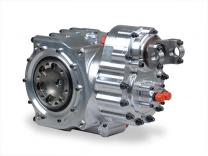Ring & Pinion Design Systems. There are three major design systems currently used to produce ring & pinion gear sets in the world today – Gleason, Oerlikon, and Klingelnberg Palloid. The different cutting methods employed by these three systems produce significantly different tooth forms. The Gleason tooth form is arc shaped and has a tooth depth that varies along the length of the tooth. The Oerlikon and Klingelnberg tooth forms have a constant tooth depth and are designed to provide a beneficial rolling motion of the gear teeth as they mesh. The Klingelnberg Palloid system, which uses hobs instead of cutters, produces a tooth form that follows a true involute curve whereas the Gleason and Oerlikon designs only approximate an involute curve.
Due to economic factors, the majority of spiral bevel and hypoid gear sets manufactured today are of the Gleason design, with most of the balance produced by the Oerlikon method. This is because the Gleason and Oerlikon tooth profiles are generated using cutter head type machines, which can produce high volumes of gears very efficiently. However, modern cutter head technology requires compromises to the tooth design and the ideal tooth shape cannot be achieved.
The Klingelnberg Palloid System. Unlike the Gleason and Oerlikon designs, Klingelnberg Palloid tooth profiles are generated using specially designed spiral hobs, which produce a gear tooth shape that is close to the theoretical ideal. The resulting gears tend to be stronger and more accurate with smoother running tooth forms, but Klingelnberg Palloid gear sets are generally more expensive to produce, especially in large production runs.
The Klingelnberg Advantage. Despite the fact that Klingelnberg Palloid gear sets are relatively expensive, they are used in many demanding fields of application, including stationary gearboxes for high tech machinery and in automotive applications where large amounts of torque and/or shock loading must be delivered through the gearbox and differential section. This is because the Klingelnberg Palloid design offers some significant advantages that justify the higher production costs. Some of these advantages include:
- Strength: Klingelnberg Palloid gears have a parallel slot width, which allows a fully rounded root region with the maximum possible root radii. This greatly improves resistance to bending stress and tooth fatigue. The small radius of the lengthwise curvature of the teeth and the high tooth contact ratio provided by the unique hobbing motion of this system greatly increases the load carrying capacity of the gear set while the true involute tooth form makes Klingelnberg Palloid gears less sensitive to gearbox and shaft deflections (case flex and shaft flex). In addition, it is possible to design gears with increased helix angle when necessary for certain applications. Since its inception, low sensitivity to deflection and high break-point capabilities have established this method as an effective means of preventing failures in highly stressed gearbox assemblies. In some applications, Klingelnberg Palloid gear sets can provide up to 25% more strength in the same size package.
- Accuracy: Teeth are generated purely by rolling motion of the hobs, which insures a high degree of tooth form accuracy. The generating process is theoretically exact and calculation of the tooth shape is relatively simple compared to cutter head generated designs. Even under high volume production conditions, the combination of continuous indexing and a single-lead hob results in very accurate tooth forms.
- Longer Gear Life: The Klingelnberg Palloid method results in extremely smooth running gear sets. The unique hobbing process provides excellent lapping conditions and enhances the inherent smooth rolling motion of the gear teeth. This feature, combined with a high tooth contact ratio, insures a long service life.
- Quiet Operation: A combination of factors, including a high degree of tooth form accuracy, a high tooth contact ratio, and the fact that involute tooth forms are relatively insensitive to deflections and mislocations during final assembly of the gearbox, insure that Klingelnberg Palloid gear sets exhibit extremely good noise behavior, even when conditions are not ideal.
- Small Minimum Batches: The Klingelnberg Palloid gear generating process requires less time to “dial in” the correct pattern, so there are less parts wasted during manufacturing. In addition, the tool setup times are short compared to the cutter head method. Hobs can be changed in a matter of minutes rather than hours. And there is no adjusting of single cutter blades, so adjustment errors are eliminated. This makes it economically feasible to make small runs of gear sets for specialty and prototype applications. This is a huge advantage over gear head cutter machines, which generally require minimum runs of 150 or more pieces.
Commitment to Excellence. As part of our ongoing effort to provide the highest quality products available, Weddle Industries is now offering ring & pinion sets made on a state of the art Klingelnberg C28P spiral bevel gear cutting machine. This machine allows us to produce a large variety of spiral bevel and hypoid ring & pinion sets with ring gear diameters up to 300mm (11.8”). If your application demands the utmost in ring & pinion performance, we have you covered.
Questions? Please call 805 562 8600 or email us.

